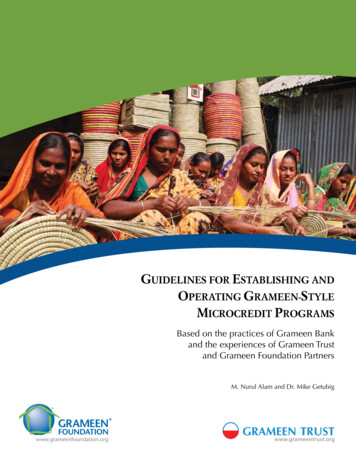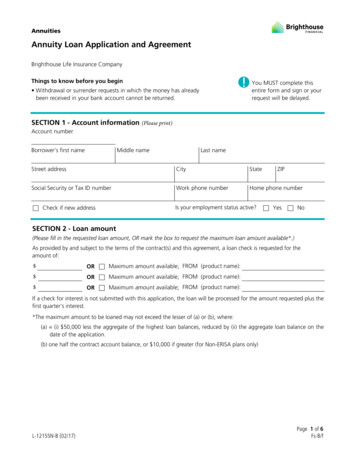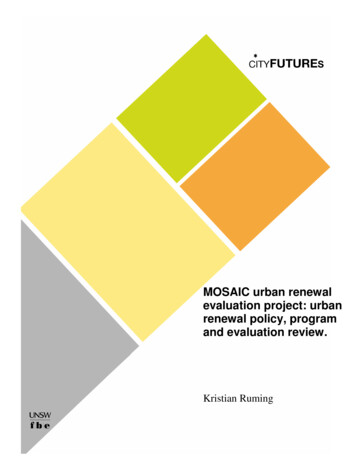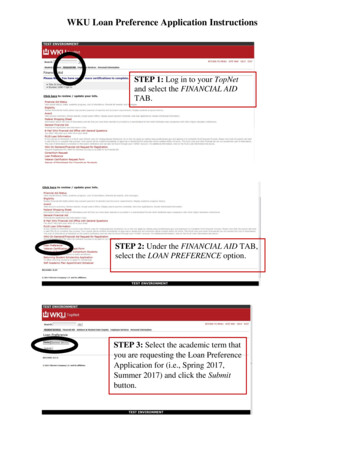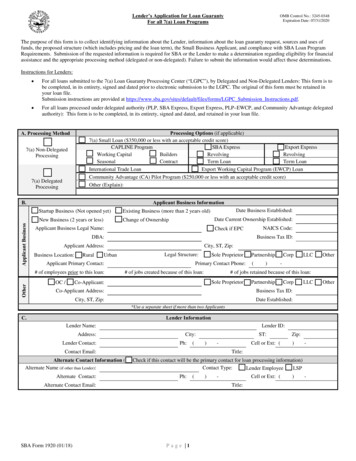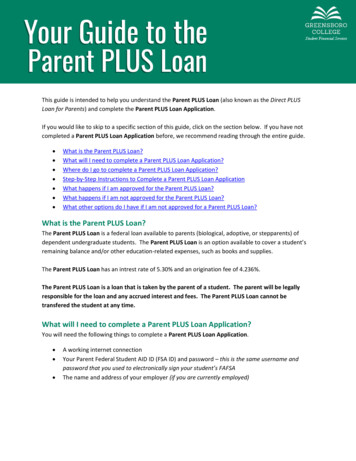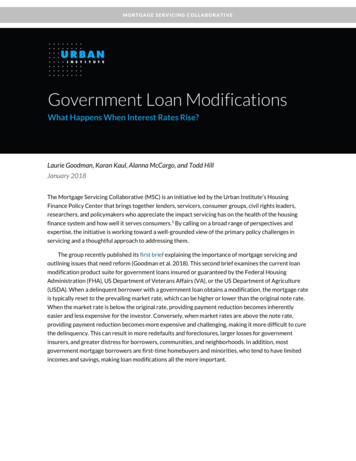
Transcription
MORTGAGE SERVICING COLLABORATIVEGovernment Loan ModificationsWhat Happens When Interest Rates Rise?Laurie Goodman, Karan Kaul, Alanna McCargo, and Todd HillJanuary 2018The Mortgage Servicing Collaborative (MSC) is an initiative led by the Urban Institute’s HousingFinance Policy Center that brings together lenders, servicers, consumer groups, civil rights leaders,researchers, and policymakers who appreciate the impact servicing has on the health of the housingfinance system and how well it serves consumers.1 By calling on a broad range of perspectives andexpertise, the initiative is working toward a well-grounded view of the primary policy challenges inservicing and a thoughtful approach to addressing them.The group recently published its first brief explaining the importance of mortgage servicing andoutlining issues that need reform (Goodman et al. 2018). This second brief examines the current loanmodification product suite for government loans insured or guaranteed by the Federal HousingAdministration (FHA), US Department of Veterans Affairs (VA), or the US Department of Agriculture(USDA). When a delinquent borrower with a government loan obtains a modification, the mortgage rateis typically reset to the prevailing market rate, which can be higher or lower than the original note rate.When the market rate is below the original rate, providing payment reduction becomes inherentlyeasier and less expensive for the investor. Conversely, when market rates are above the note rate,providing payment reduction becomes more expensive and challenging, making it more difficult to curethe delinquency. This can result in more redefaults and foreclosures, larger losses for governmentinsurers, and greater distress for borrowers, communities, and neighborhoods. In addition, mostgovernment mortgage borrowers are first-time homebuyers and minorities, who tend to have limitedincomes and savings, making loan modifications all the more important.
About the Mortgage Servicing CollaborativeThe Housing Finance Policy Center’s Mortgage Servicing Collaborative is a research initiative that seeks to identify and buildmomentum for servicing reforms that make the housing market more equitable and efficient.One core MSC objective is to improve awareness of the role and importance of mortgage servicing in the housing financesystem. Since 2013, HFPC researchers have studied the landscape, followed the work and policies put in place after thecrisis, and assessed the impact of the servicing industry on consumers and communities. This includes loss mitigation andforeclosure actions and how servicing practices affect access to credit through tight underwriting standards. The UrbanInstitute has analyzed and convened forums on emerging issues in mortgage servicing, including calls for reforms, the impactof mortgage regulation, the rise of nonbank servicers, and the implications for consumers and communities. We determinedthat a focused effort that involves external stakeholders and resources could lead the way in developing policy andstructural recommendations and bring visibility to the important issues that lie ahead.The MSC has convened key industry stakeholders—including lenders, servicers, consumer groups, civil rightsorganizations, academics, and regulators—to develop an evidence-based understanding of important factors and to developand analyze solutions and implications with a well-rounded and actionable orientation.The MSC seeks to bring new evidence, data, and recommendations to the forefront; foster debate and analysis on issues from regulatory reform, technology innovations, cost containment, and consumeraccess to mortgages; and produce and disseminate our research findings and policy recommendations—including perspectives by MSC members—to offer policy options that can clarify and advance the debate and ensure servicing is addressed in broader housingfinance reform.For more information about the MSC or to see other publications, news, and products, visit the MSC program collaborative.Mortgage Servicing Collaborative Participants AmeriFirst: Mark Jones and Greg WarnerBank of America: Terry Laughlin and Larry WashingtonBayview: Rich O’Brien and Julio AldecoceaBlack Knight Financial Services: Joseph NackashiCaliber Home Loans: Tricia Black, Marion McDougall, and Lori FosterColonial Savings: David Motley and Jane LarkinGenworth: Steve Hall and Carol BouchnerGuild Mortgage Company: David BattanyHousing Policy Council and Hope Now: Paul Leonard, Meg Burns, and Eric SelkJPMorgan Chase: David Beck, Ramon Gomez, Erik Schmitt, and Diane KortKatie Porter: Faculty at University of California, IrvineMortgage Bankers Association: Justin Wiseman, Mike Fratantoni, and Sara SinghasMr. Cooper: Jay Bray and Dana DillardNational Community Stabilization Trust: Julia GordonNational Fair Housing Alliance: Lisa RiceNorthern Ohio Investment Corp.: Mark VinciguerraOcwen: John Britti and Jill ShowellPatricia McCoy: Faculty at Boston CollegePennyMac: David Spector and Karen ChangPricewaterhouseCoopers: Sherlonda Goode-Jones, Peter Pollini, and Genger CharlesQuicken Loans: Mike Malloy, Pete Carroll, and Alex McGillisSelf Help Credit Union/Center for Responsible Lending: Martin Eakes and Mike CalhounTed Tozer: Milken Institute, Former President of Ginnie MaeUnion Home Mortgage: Bill CosgroveU.S. Bank: Bryan BoltonWells Fargo: Brad Blackwell, Raghu Kakumanu, and Laura Arce
This brief explains why FHA, VA, and USDA borrowers who fall behind on their payments areunlikely to receive adequate payment relief when the market interest rate is higher than the originalnote rate. We explore the Flex Modification (Flex Mod) framework announced by the Federal HousingFinance Agency for use by Fannie Mae and Freddie Mac (the government-sponsored enterprises, orGSEs), which provides payment relief even when rates rise.2 We argue that, with some changes to theloan modification options at the FHA, VA, and USDA, current and future delinquent borrowers could bebetter served in a high-rate environment. This brief is structured as follows: Description of the current loan modification product suite for government mortgage loans Problem statement and explanation of why government loan modifications do not serveborrowers when interest rates rise Discussion of potential solutions and recommendations for expanding the loss mitigationtoolkit, with an explanation of how it would work Explanation of likely barriers to implementation and how to best overcome themGovernment Loan Modifications TodayFederal Housing Administration, VA, and USDA modifications use three primary levers: (1) rate resetsto market rate (subject to certain conditions), (2) term extensions, and (3) partial claims.Resets to the market rate. The interest rate on an FHA, VA, or USDA loan is generally reset to theprevailing market rate at the time of modification, even if it results in a rate increase for the borrower.3The modification interest rate cannot be set below the market rate because the loans have to be repooled into new mortgage-backed securities (MBS), which must be issued at the market rate to attractMBS investor interest. This hampers servicer ability to provide meaningful payment relief to borrowers.Market rate modifications have been a moot issue in recent years because declining long-term interestrates pushed the market rate to very low levels. As a result, crisis-era borrowers, most of whom hadhigh-interest-rate original mortgages, have received meaningful payment reduction.The USDA offers two types of loan modifications with distinct interest rate requirements: thetraditional loan servicing modification and the special loan servicing modification (USDA 2017,attachment 18-A). Under the traditional option, the rate cannot be increased above the original noterate. But if the market rate is above the original note rate, the servicer would have to bear the cost of abelow-market-rate modification, rendering the modification unattractive for the servicer and limitingits practical use. The special modification option, which can be used only after the borrower has beenevaluated for a traditional modification, allows a rate increase capped at the Primary Mortgage MarketSurvey (PMMS) rate plus 50 basis points.4 Although this is more cost effective for the servicer, the rateincrease does not help the borrower.Term extensions and partial claims. Federal Housing Administration, VA, and USDA modificationscan generally extend the loan term to 360 months, which helps lower the payment. In contrast, GSE FlexGOVERNMENT LOAN MODIFICATIONS: WHAT HAPPENS WHEN INTEREST RATES RISE?3
Mod can extend the term to up to 480 months. The USDA’s special modification allows a term extensionto 480 months with prior approval. The FHA and USDA also cover up to 30 percent of the unpaidprincipal balance (UPB) using a partial claim for FHA borrowers and a Mortgage Recovery Advance(MRA) for USDA borrowers.5 These mechanisms allow the FHA and USDA to pay the servicer a portionof the loan balance, which the servicer uses to reduce the outstanding balance on the loan, therebyachieving greater payment reduction. The borrower then repays this sum to the FHA or USDA when theentire loan is paid off. The VA does not have a partial claim or MRA equivalent. Although itoffers principal forbearance, the VA does not reimburse the servicer, thus reducing servicer ability andlimiting the effectiveness of this option. Additionally, Ginnie Mae does not allow loans with deferredprincipal balances to be included in a Ginnie Mae MBS pool. Table 1 compares the current modificationoptions for the FHA, VA, USDA, and the GSEs.TABLE 1Comparison of Current FHA, USDA, VA, and GSE Modification ToolkitsFHA mod.USDA mod.VA mod.Rate reductionNo more than PMMS 25 bpsSet rate to PMMS 50 bps; rate increasecapped at 1%Set rate to lower ofPMMS or original rateTerm extensionExtend to 360monthsExtend to 360monthsExtend to 480 monthsMortgagebalancereductionPartial claim of up to30% of defaultedUPBNo more than original rate fortraditional mods.; no more thanPMMS 50 bps for specialmods.Extend to 360 months fortraditional or 480 months forspecialMRA of up to 30% of defaultedUPB (once over life of loan)PostmodificationpoolingRe-pool at marketrate; below-marketrate mods. at servicerexpenseNo partial claim orMRA; principalforbearance atservicer expenseRe-pool at marketrate; below-marketrate mods. at servicerexpenseForbear principal to100% LTV, subject to capof 30% of UPB or 80%MTMLTVaHeld in GSE portfolios;below-market-ratemods. at GSE expenseRe-pool at market rate; belowmarket-rate traditional mods.at servicer expenseGSE Flex ModNote: bps basis points; FHA Federal Housing Administration; GSE government-sponsored enterprise; LTV loan-to-valueratio; MRA Mortgage Recovery Advance; PMMS Freddie Mac Primary Mortgage Market Survey; UPB unpaid principalbalance; USDA US Department of Agriculture; VA US Department of Veterans Affairs.aMTMLTV, or mark-to-market loan-to-value ratio, is the unpaid principal balance of a mortgage divided by the current propertyvalue. It is a measure of how much equity (or negative equity) a borrower has in the home.Why Are FHA, VA, and USDA Loan ModificationsInadequate in a Rising Interest Rate Environment?Research has shown that one of the main drivers of successful loan modification is meaningful paymentrelief (Schmeiser and Gross 2016). Payment reduction can be achieved by extending the term of theloan, reducing the interest rate on the loan, reducing the loan balance, or a combination of the three.Federal Housing Administration, VA, and USDA modifications cannot provide any of these aggressivelyenough when interest rates rise. Additionally, government modifications rely on servicer willingness to4GOVERNMENT LOAN MODIFICATIONS: WHAT HAPPENS WHEN INTEREST RATES RISE?
absorb some of the costs associated with modifications (such as for below-market-rate modifications orthe VA’s principal forbearance). These restrictions limit the number of borrowers that can be assistedand the amount of payment reduction for borrowers who receive modifications.A simple example illustrates the problem (table 2). The first column shows loan characteristics atthe time of default. The other columns show how this loan would be modified under different programs.In this example, the original mortgage with a note rate of 3.5 percent goes delinquent when marketinterest rates have risen to 5 percent. Assume that the UPB at default is 148,000 and that theborrower has missed four payments. The arrearages for this loan (delinquent interest, taxes, andinsurance) add up to 4,243, and the capitalized UPB equals 152,243 ( 148,000 plus 4,243). Let usnow look at the modifications currently available to for FHA, VA, USDA, and GSE borrowers.TABLE 2Payment Relief Options under Current Modification Programs (5 Percent Market Rate)UPB at defaultCapitalized UPBPartial claim or MRAInterest-bearing UPBInterest rateRemaining term (months)P&ITaxes and insuranceFHA monthly MIPMonthly paymentDelinquent paymentsMonthly payment reductionP&I reductionOriginalloan (atdefault)FHA mod.(partialclaim)VA mod. 148,000N/AN/AN/A3.5%330 699 250 167 1,1164N/AN/AN/A 152,243 44,400 107,8435.0%360 579 250 167 9964-10.8%-17.2%N/A 152,243 0 152,2434.5%360 771 250 0 1,02147.6%10.4%USDA mod. (MRA)GSE FlexMod (100%MTMLTV)GSE FlexMod (115%MTMLTV)N/A 152,243 44,400 107,8433.5% traditional; 5% special360 484 or 579 250 0 734 or 8294-22.6% traditional; -12.6% special-30.7% traditional; -17.1% specialN/A 152,243 7,888 144,3553.5%480 559 250 0 8094-14.7%-20.0%N/A 152,243 19,858 132,3853.5%480 513 250 0 7634-19.6%-26.6%Notes: FHA Federal Housing Administration; MIP Mortgage Insurance Premium; MRA Mortgage Recovery Advance; P&I principal and interest; MTMLTV mark-to-market loan-to-value ratio; N/A not applicable; UPB unpaid principal balance;USDA US Department of Agriculture; VA US Department of Veterans Affairs. The percent payment reduction calculations forthe VA, USDA, and Flex Mod exclude the 167 MIP, which is applicable only to the FHA.There are three take-aways from this table:1.Government modifications are less sustainable. In the example above, the modification ratefor FHA and USDA special modification loans is 5 percent. For VA loans, the rate is 4.5 percent,as the VA caps rate increases at 1 percent. The FHA and USDA allow partial claim or MortgageRecovery Advance (PC/MRA), which helps offset the effect of the rate increase. In the example,the amount of the partial claim for the FHA and USDA is 44,400, reducing the interest-bearingUPB from 152,243 to 107,843. The FHA and VA cap extended loan terms at 360 months.The USDA’s special loan modification allows a 480-month loan term, but capital market pricingGOVERNMENT LOAN MODIFICATIONS: WHAT HAPPENS WHEN INTEREST RATES RISE?5
and execution of 40-year securities is inefficient, rendering this option largely unhelpful.Although FHA and USDA modifications lower monthly payments, the reduction is below the 20percent level typically needed for meaningful relief. The monthly payment reduction is only10.8 percent for FHA modifications and 12.6 percent for USDA special modifications. None ofthis is to suggest that a smaller payment reduction will not trim redefault rates. Rather, itsuggests that a larger payment reduction would cut the redefault rate even more and helpminimize losses.The monthly payment reduction under the USDA’s traditional modification (22.6 percent) inthe example, while substantial, comes with a big caveat: the cost of keeping the modificationinterest rate the same as the original note rate must be borne by the servicer, rendering thisoption very expensive. In other words, although payment reduction under the USDA’straditional modification is substantial, servicer ability for offering this modification is limited.The special modification, which resets the rate to market rate and results in a smaller paymentreduction, is more likely to be employed when rates are higher.2.VA modifications have additional challenges. The VA has made improvements in recent yearsto better assist borrowers, initially through the streamlined modification program in 2016 anddisaster relief announcement in 2017. The VA also offers the VA Affordable Modification,which allows principal forbearance to set aside a portion of the outstanding loan balance. Butservicers do not get reimbursed for the forborne amount, as they do under the FHA partialclaim and the USDA’s MRA. This reduces servicer ability to offer principal forbearance, limitingits use. Thus, when a VA borrower obtains a modification in a rising rate environment, the rateis reset to the market rate which, absent principal forbearance, increases the monthly payment.In the example, the borrower would see a 7.6 percent increase in the monthly payment.3.Payment relief under Flex Mod. The last two columns show how the GSE Flex Mod would treatthe same borrower. Unlike FHA, VA, and USDA modifications, Flex Mod is based on a mark-tomarket loan-to-value ratio (MTMLTV), which takes into account the current property value.This metric allows GSEs to tailor loan modification to provide greater payment relief tounderwater or deeply underwater borrowers. For borrowers with an MTMLTV ratio between80 and 100 percent, after resetting the rate to the lower of the original rate or market rate andextending the term to 480 months, Flex Mod forbears principal until 20 percent paymentreduction is achieved. For MTMLTV ratios above 100 percent, Flex Mod forbears principal untilan MTMLTV ratio of 100 percent is achieved.6 If a 100 percent MTMLTV ratio, rate reset, andterm extension do not yield a 20 percent payment reduction, Flex Mod provides additionalforbearance until either a 20 percent payment reduction is achieved or the maximumforbearance is reached (30 percent of UPB or 80 percent MTMLTV).Also, the GSEs have a portfolio, which enables them to buy delinquent loans out of pools and holdthem indefinitely without having to redeliver back into a security. This gives GSEs additional flexibilityin designing loan modification programs and reduces reliance on servicers. The FHA, VA, and USDA, on6GOVERNMENT LOAN MODIFICATIONS: WHAT HAPPENS WHEN INTEREST RATES RISE?
the other hand, typically do not use a portfolio to warehouse delinquent loans, and they rely more onservicers.Recommendations That Produce Greater PaymentRelief for FHA, VA, and USDA BorrowersMortgage Servicing Collaborative members discussed four options that could increase payment reliefavailable to FHA, USDA, and VA borrowers in a rising rate environment: Partial claim with recast for the FHA and USDA (i.e., modify mortgages within the pool toeliminate re-pooling) Principal forbearance for the FHA, USDA, and VA Extend mortgage terms to 40 years Create a balance sheet for warehousing modified unsecuritized loansMembers of the MSC agree that the first two options are easier to implement in the near term. Thelast two, while possible in the long run, are unrealistic in the near term for the following reasons.40-year extended term. The secondary market for 40-year-term MBS is small, and securities pricesin this market are less competitive. Moreover, in a rising rate environment, market participants are lesslikely to take on long-duration risk, making the market rate on a 40-year mortgage even less economic.We estimate that 40-year MBS rates are 50 basis points above comparable 30-year securities. Thatsaid, it is possible to develop this market over the long run, but some subsidy will probably be needed toassure economic execution during the interim period.Balance sheet execution for modified loans. This option would allow the FHA, VA, USDA, or GinnieMae to purchase delinquent loans out of the pool and hold them in portfolio as whole loans, similar tohow the GSEs operate. A portfolio would also facilitate a 40-year extended term, as it would provide analternative to re-pooling. But Ginnie Mae does not have the authority to run a portfolio and is unlikelyto obtain it. The FHA has statutory authority, but the VA and USDA do not. Although this option wouldexpand the scope for more meaningful modifications, it remains a long-term option. To get there, theFHA would need additional funding to repurchase loans out of the pool and to build a newinfrastructure of skilled professionals, risk managers, systems, and processes for managing a largeportfolio of delinquent and modified loans.This leaves the first two options: partial claim with recast and increased use of principalforbearance. Mortgage Servicing Collaborative members agree that these are more attainable andeasier to implement in the short term.Combine partial claim (or MRA) with recast. The FHA and USDA already use a partial claimapproach. Under the current approach, the loan is bought out of the pool; delinquent interest, taxes, andGOVERNMENT LOAN MODIFICATIONS: WHAT HAPPENS WHEN INTEREST RATES RISE?7
insurance are capitalized; the interest rate is set to the market rate (as applicable); the term is extendedto 360 months; and PC/MRA reduces the principal balance to achieve the desired payment reduction.But resetting a 3.5 percent mortgage to, say, 5 percent, could curb the ability to achieve payment relief.In such situations, it would be advantageous to leave the loan inside the pool, apply PC/MRA funds, andrecast the reduced loan balance with the remaining term and original 3.5 percent rate. This is similar tothe GSE Flex Mod, which gives borrowers the lower of the market rate or their current rate (table 3).This option could also be combined with a reduction in the FHA Mortgage Insurance Premium for evengreater payment relief. This would reduce revenues for the FHA, but if the corresponding reduction inredefault rates produces greater benefit, it would be a net positive for the Mutual Mortgage InsuranceFund.Use of principal forbearance. This option would deploy principal forbearance in lieu of PC/MRA forFHA and USDA loans. This would be a new tool for the VA, as it does not reimburse servicers for thecost of forbearance. Under this proposal, the loan would be bought out of the pool, the delinquentarrearages would be capitalized, the interest rate would be reset to the market rate, the term would beextended, and forbearance would reduce the principal balance to achieve the desired paymentreduction. The new (reduced) principal balance would be securitized while the forborne portion wouldbe due and payable to the FHA, VA, or USDA when the loan is paid off or the property sold (as is the casefor partial claims).This is similar to FHA and USDA loans, except that PC/MRA is replaced with the less cumbersomeforbearance. Processing a PC/MRA requires servicers to record a subordinate lien; forbearance doesnot. In lieu of the junior lien, the principal forbearance would be outlined in the modified note. Principalforbearance would be a win, especially for veterans, because the VA does not reimburse servicers forthe forborne amount, reducing servicer motivation to use this option. The forbearance amount for theVA would be limited to 25 percent of the capitalized UPB because of the VA’s partial guaranty. Theprincipal forbearance options could be combined with a reduction in the Mortgage Insurance Premiumfor even greater payment relief.Table 3 shows the payment reduction under these proposals for the same borrower situation as intable 2. The PC/MRA with recast within the pool would result in the largest payment reduction, as theborrower avoids the rate increase. The FHA and USDA forbearance option results in the same paymentreduction as current PC/MRA but is less cumbersome to administer. Most importantly, the proposedVA forbearance option would reduce the capitalized principal balance by 25 percent (the VA’smaximum guaranty), resulting in a reduction in the VA borrower’s monthly payment, in contrast to anincrease in table 2.8GOVERNMENT LOAN MODIFICATIONS: WHAT HAPPENS WHEN INTEREST RATES RISE?
TABLE 3Borrower Payment Relief Options under Proposed Solution (5 Percent Market Rate)Originalloan (atdefault)UPB at defaultCapitalized UPBPC/MRA or forbearanceInterest-bearing UPBInterest rateTermP&ITaxes and insuranceFHA monthly MIPPITIDelinquent paymentsMonthly payment reductionP&I reduction 148,000N/AN/AN/A3.5%330 699 250 167 1,116N/AN/AN/AFHA partialclaim recastN/A 152,243 44,400 107,8433.5%330 509 250 167 9264-17.0%-27.1%USDA MRA recast(traditionalmod.)N/A 152,243 44,400 107,8433.5%330 509 250 0 7594-20.0%-27.1%FHAforbearanceN/A 152,243 44,400 107,8435.0%360 579 250 167 forbearanceN/A 152,243 44,400 107,8433.5%360 484 250 0 7344-22.6%-30.7%N/A 152,243 38,061 114,1824.5%330 604 250 0 8544-10.0%-13.6%Note: FHA Federal Housing Administration; MIP Mortgage Insurance Premium; N/A not applicable; PC/MRA partial claimor Mortgage Recovery Advance; P&I principal and interest; PITI principal, interest, taxes, and insurance; UPB unpaidprincipal balance; USDA US Department of Agriculture; VA US Department of Veterans Affairs.Barriers to ImplementationBelow, we describe barriers to implementation for the use of PC/MRA with recast and principalforbearance and propose ways to overcome them.Barriers to PC/MRA with RecastThe main obstacle to partial claim with recast is that the Ginnie Mae MBS guide does not permit loans tobe re-amortized while in a Ginnie Mae pool. This rule is governed by 24 CFR 320.5(a), which requiresthat “specified” payments be made to security holders. Because processing a partial claim with recastwould reduce loan balances and pass-through payments scheduled to be received by MBS investors,this regulation would need to be modified. The partial claim with recast option would also requirechanges to FHA and USDA PC/MRA rules to permit a PC/MRA with principal curtailment. These issuesare small and can be handled through rulemaking.The bigger obstacles to this proposal are as follows:The VA does not have partial claim authority. The VA does not have statutory authority tooriginate loans in its name, which is essential to using partial claims or MRA. Under the FHA’s partialclaim or the USDA’s MRA, the amount by which the loan balance is reduced is used to create asubordinate mortgage in the government insurer’s name. It would take congressional action to have theVA offer partial claims in this manner. But there is a potential workaround. The VA has a loss mitigationGOVERNMENT LOAN MODIFICATIONS: WHAT HAPPENS WHEN INTEREST RATES RISE?9
refunding option, which is rarely used. Under this option, the VA purchases a delinquent loan from theservicer and assumes primary servicing responsibilities. The original mortgage note is endorsed to theVA, and the mortgage is recorded as assigned to the VA. Once a mortgage is assigned under therefunding option, the VA could then offer principal forbearance to achieve greater payment reductionthan is possible today.MBS investor opposition to recast. A second obstacle is MBS investors’ opposition because of thepotential for a reduction in scheduled payments under the recast proposal. Investors will likely objectthat the ground rules under which they purchased the securities have been retroactively changed. Thatis, investors bought the securities assuming the loans would be pulled out of the pool before they wouldbe modified. Investors prefer that a delinquent loan be pulled out of the pool in a rising rateenvironment because they can then reinvest the proceeds at the higher market rate. Investors wouldlose this benefit under the recast proposal. Changes to the guidelines could be made prospectively (e.g.,only pools issued after a certain future date would permit recasting). Investors would then know, whenthey buy a pool, that it would have the recast option. But changes could also be made retroactivelybecause the modification wave on crisis-era securities is over, and new originations are pristine withextremely low delinquency rates. In other words, making this change retroactively is unlikely to becostly for investors or disruptive to MBS markets but could help borrowers who might fall behind in thecoming years.Barriers to Expanded Use of Principal ForbearanceThe barriers to the principal forbearance proposal are lower. The proposal would require Ginnie Mae toallow non–fully amortizing loans into Ginnie Mae pools. Making this change should not have anoticeable impact on investors, as the portion of loans sold to investors would be fully amortizing. Therewould be an additional lump sum (equal to the amount of the principal forbearance) due at payoffoutside the securitization. This is economically no different than what is allowed today when poolingmodified loans with PC/MRA. Although this option would create uncertainty for MBS investors, as theyare unsure of the effect of principal forbearance on prepayments, much of this risk exists today withPC/MRA modifications. This change is likely to have minimal impact on securities prices.The bigger change would be for the VA because it would need to build the infrastructure forprincipal forbearance and reimburse servicers under the loss mitigation refunding option. We suggestcapping the amount of forbearance at the value of the VA guaranty, which is 25 percent of the homevalue.ConclusionBorrowers with FHA, VA, and USDA loans do not have access to modification programs that result inmeaningful payment reduction in a high-rate environment. The recommendations in this brief couldstrengthen the government loan modification product suite and create better financial outcomes forborrowers and the government agencies insuring loans. The Mortgage Servicing Collaborative has10GOVERNMENT LOAN MODIFICATIONS: WHAT HAPPENS WHEN INTEREST RATES RIS
The USDA offers two types of loan modifications with distinct interest rate requirements: the traditional loan servicing modification and the special loan servicing modification (USDA 2017, attachment 18-A). Under the traditional option, the rate cannot be increased above the original note rate.

